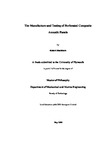The Manufacture and Testing of Perforated Composite Acoustic Panels
| dc.contributor.author | Blackburn, Robert | |
| dc.date.accessioned | 2016-04-21T16:29:39Z | |
| dc.date.available | 2016-04-21T16:29:39Z | |
| dc.date.issued | 2009-05-01 | |
| dc.identifier.uri | http://hdl.handle.net/10026.1/4531 | |
| dc.description | A thesis submitted to the University of Plymouth in partial fulfilment for the degree of Master of Philosophy, Department of Mechanical and Marine Engineering, Faculty of Technology | en_US |
| dc.description.abstract |
The recent expansion of civil aviation has been accompanied by significant growth in the use of advanced composite structures with carbon fibre reinforced epoxy often the material of choice in many structures. Composite structures have a long history in engine nacelles, where an optimised design can both fulfil structural requirements and simultaneously provide an acoustic liner for sound attenuation. The "traditional process" involves the drilling of high-density multiple holes with the twin consequences of extended production times and machining waste. Elimination of this perforation process is an attractive target in a commercial environment. Structural performance could be improved by retaining fibre continuity whilst controlling fibre paths around the perforations through a moulding approach. This thesis reports an investigation to evaluate novel approaches to moulding multiple perforations in composite structures and the application of those approaches in both traditional pre-preg and resin infusion processing technologies. Two approaches were explored: castable soluble pins and an adaptation of z-pinning technology. The composites produced using one of these techniques were subjected to mechanical testing (tension, compression and interlaminar shear) both dry and after exposure to hot/wet conditions. The laminates were also characterised for thickness variation, fibre volume fraction, degree-of-cure, glass transition temperature and acoustic impedance. These validations demonstrated that while significant improvements to property retention can be achieved for tensile loading conditions, certain compression conditions fail to achieve the same benefits. It was also found that a key aspect to implementing any perforation moulding technique lies in consistently achieving high quality hole definition to retain acoustic impedance performance. From the concept characterisation, a preliminary weight and detailed cost analysis were developed to assess the industrial feasibility for the method developed. This analysis showed that, with further investigation and the right application selection, the benefits of the novel approach could be realised. | en_US |
| dc.description.sponsorship | In collaboration with GKN Aerospace Limited | en_US |
| dc.language.iso | en | en_US |
| dc.subject | Master of Philosophy | |
| dc.title | The Manufacture and Testing of Perforated Composite Acoustic Panels | en_US |
Files in this item
This item appears in the following Collection(s)
-
Masters Dissertations: Faculty of Science and Engineering
Items in this collection are available only to University of Plymouth staff and students.


